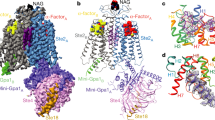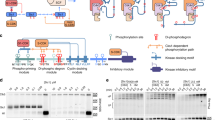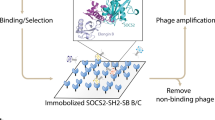Abstract
Serine/threonine protein kinases of the Ste20/PAK family have been implicated in the signalling from heterotrimeric G proteins to mitogen-activated protein (MAP) kinase cascades1,2. In the yeast Saccharomyces cerevisiae, Ste20 is involved in transmitting the mating-pheromone signal from the βγ-subunits (encoded by the STE4 and STE18 genes, respectively) of a heterotrimeric G protein to a downstream MAP kinase cascade1. We have identified a binding site for the G-protein β-subunit (Gβ) in the non-catalytic carboxy-terminal regions of Ste20 and its mammalian homologues, the p21-activated protein kinases (PAKs). Association of Gβ with this site in Ste20 was regulated by binding of pheromone to the receptor. Mutations in Gβ and Ste20 that prevented this association blocked activation of the MAP kinase cascade. Considering the high degree of structural and functional conservation of Ste20/PAK family members and G-protein subunits, our results provide a possible model for a role of these kinases in Gβγ-mediated signal transduction in organisms ranging from yeast to mammals.
This is a preview of subscription content, access via your institution
Access options
Subscribe to this journal
Receive 51 print issues and online access
$199.00 per year
only $3.90 per issue
Buy this article
- Purchase on Springer Link
- Instant access to full article PDF
Prices may be subject to local taxes which are calculated during checkout






Similar content being viewed by others
References
Leberer, E., Thomas, D. Y. & Whiteway, M. Pheromone signalling and polarized morphogenesis in yeast. Curr. Opin. Genet. Dev. 7, 59–66 (1997).
Sells, M. A. & Chernoff, J. Emerging from the Pak: the p21-activated protein kinase family. Trends Cell Biol. 7, 162–167 (1997).
Peter, M., Neiman, A. M., Park, H.-O., Lohuizen, L. v. & Herskowitz, I. Functional analysis of the interaction between the small GTP binding protein Cdc42 and the Ste20 protein kinase in yeast. EMBO J. 15, 7046–7059 (1996).
Leberer, E. et al. Functional characterization of the Cdc42p binding domain of yeast Ste20p protein kinase. EMBO J. 16, 83–97 (1997).
Chang, F. & Herskowitz, I. Phosphorylation of FAR1 in response to α-factor: a possible requirement for cell-cycle arrest. Mol. Biol. Cell 3, 445–450 (1992).
Gartner, A., Nasmyth, K. & Ammerer, G. Signal transduction in Saccharomyces cerevisiae requires tyrosine and threonine phosphorylation of FUS3 and KSS1. Genes Dev. 6, 1280–1292 (1992).
Wu, C. et al. Activation of myosin-I by members of the Ste20p protein kinase family. J. Biol. Chem. 271, 31787–31790 (1996).
Whiteway, M. S. et al. Association of the yeast pheromone response G protein βγ subunits with the MAP kinase scaffold Ste5p. Science 269, 1572–1575 (1995).
Bagrodia, S., Taylor, S. J., Creasy, C. L., Chernoff, J. & Cerione, R. A. Identification of a mouse p21Cdc42/Rac activated kinase. J. Biol. Chem. 270, 22731–22737 (1995).
Cvrckova, F., Devirgilio, C., Manser, E., Pringle, J. R. & Nasmyth, K. Ste20-like protein kinases are required for normal localization of cell growth and for cytokinesis in budding yeast. Genes Dev. 9, 1817–1830 (1995).
Leberer, E., Dignard, D., Hougan, L., Thomas, D. Y. & Whiteway, M. Dominant-negative mutants of a yeast G-protein β subunit identify two functional regions involved in pheromone signaling. EMBO J. 13, 4805–4813 (1992).
Wall, M. A. et al. The structure of the G protein heterotrimer Gi α1 β1 γ2. Cell 83, 1047–1058 (1995).
Sondek, J., Bohm, A., Lambright, D. G., Hamm, H. E. & Sigler, P. B. Crystal structure of a G-protein βγ dimer at 2.1A resolution. Nature 379, 369–374 (1996).
Wu, C. L., Whiteway, M., Thomas, D. Y. & Leberer, E. Molecular characterization of Ste20p, a potential mitogen-activated protein or extracellular signal-regulated kinase kinase (MEK) kinase kinase from Saccharomyces cerevisiae. J. Biol. Chem. 270, 15984–15992 (1995).
Leberer, E. et al. Cloning of Saccharomyces cerevisiae STE5 as a suppressor of a Ste20 protein kinase mutant: structural and functional similarity of Ste5 to Far1. Mol. Gen. Genet. 241, 241–254 (1993).
Sikorski, R. S. & Hieter, P. Asystem of shuttle vectors and yeast host strains designed for efficient manipulation of DNA in Saccharomyces cerevisiae. Genetics 122, 19–27 (1989).
Leberer, E., Dignard, D., Harcus, D., Thomas, D. Y. & Whiteway, M. The protein kinase homologue Ste20p is required to link the yeast pheromone response G-protein βγ subunits to downstream signalling components. EMBO J. 11, 4815–4824 (1992).
Kunkel, T. D., Roberts, J. D. & Zakour, R. A. Rapid and efficient site-specific mutagenesis without phenotypic selection. Meth. Enzymol. 154, 367–382 (1987).
Leeuw, T. et al. Pheromone response in yeast: association of Bem1p with proteins of the MAP kinase cascade and actin. Science 270, 1210–1213 (1995).
Manser, E., Leung, T., Salihuddin, H., Zhao, Z. S. & Lim, L. Abrain serine/threonine protein kinase activated by Cdc42 and Rac1. Nature 367, 40–46 (1994).
Acknowledgements
We thank A. Nantel for helpful discussion, D. Harcus, D. Dignard and L. Johnson for excellent technical assistance, R. Tsien for supplying the GFP plasmid and S. Sprang for providing the Gβ1 structure coordinates. The NRC publication number for this work is 39976.
Author information
Authors and Affiliations
Corresponding author
Rights and permissions
About this article
Cite this article
Leeuw, T., Wu, C., Schrag, J. et al. Interaction of a G-protein β-subunit with a conserved sequence in Ste20/PAK family protein kinases. Nature 391, 191–195 (1998). https://doi.org/10.1038/34448
Received:
Accepted:
Issue Date:
DOI: https://doi.org/10.1038/34448
This article is cited by
-
Negative feedback-loop mechanisms regulating HOG- and pheromone-MAPK signaling in yeast
Current Genetics (2020)
-
G-protein βγ subunits as multi-functional scaffolds and transducers in G-protein-coupled receptor signaling
Cellular and Molecular Life Sciences (2019)
-
Evolutionary dynamics in the fungal polarization network, a mechanistic perspective
Biophysical Reviews (2017)
-
Mediation of fludioxonil fungicide activity and resistance through Cochliobolus heterostrophus G-protein and MAPK signaling pathways
Phytoparasitica (2015)
-
A framework for mapping, visualisation and automatic model creation of signal‐transduction networks
Molecular Systems Biology (2012)
Comments
By submitting a comment you agree to abide by our Terms and Community Guidelines. If you find something abusive or that does not comply with our terms or guidelines please flag it as inappropriate.



